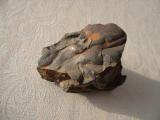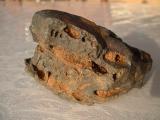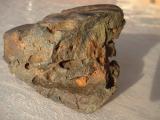A friend of mine, Clifford M, is from Kerala, India. On a recent trip there, he found an interesting area in a rubber plantation full of what looks like previously molten metal. If you can identify this object with certainity, then please contact me.
Description
The area where these objects are found used to be jungle until a century ago. It is now a rubber plantation. In order to make it arable, the area had to be cleared from a lot of fragments of what appears like previously molten metal. These objects were found on the surface, as well as under it. The sizes vary from walnut size to tens of centimeters.
Upon testing for magnetism, this fragment was found to be ferrous in nature, i.e. composed of iron and/or nickel.
Theories
Cliff, another friend, Jim, and myself had a brain storming session on this object. During that session we discovered that it is magnetic. Here are the various postulates we have:
Volcanic Origin
I am not sure that volcanoes can spew out ferric material or not. Mostvolcanoes would have silicate based lava and other rock types. There isalso no known volcano in the area.
Meteorite
Many meteorites are magnetic, being made of nickel and iron. However,meteors do not normally have time to melt and solidify as they pass inEarth's atmosphere. Could it be the super heated surface shattering onimpact and splattering over the area?
In any case, a phone call to a geologist at the University of Waterloo confirmed that this cannot be a meteorite. He was leaning towards the next theory.
Slag from an ancient Foundry
The object is very similar to archeometallurgic slag mentioned on the sites listed in the references.
However, why would ancient people toil extracting massive amounts ofiron ore, only to waste the product and spill it on the ground?
How far would the source of iron reasonably be?
No known civilization has inhabited this place, which was jungle untila century ago. Moreover, Cliff looked for pits with charred remains from the massive fires needed to extract iron from the ore. There were none. If there were any, they would be a good candidate for carbon dating.
If this is proven to be an ancient foundry, then itwould cause the current knowledge on the region to be reevaluated.
Pictures
Here are pictures of the object that he was able to get back. It is a fairly small sample compared to others in the area.
References
The following sites may be of interest:






Comments
Anonymous (not verified)
Khalid, Have you had any
Sun, 2007/04/15 - 20:43Khalid,
Have you had any luck identifying this rock? I recently found one almost identical to it while digging a garden plot in New Hampshire. Actually, I found two. They are both slightly magnetic. The larger one is about 6" x 4" and is identical in structure to yours, with the molten furrows on one side and grainy-pitted underside. The other, found within a couple feet of the first, is about 2" x 3". The smaller one looks more like a traditional meteorite on one side, with deep and distinct craters at various angles. The back side of the smaller one does not have the molten furrows, but neither does it have the craters. It is more like furrows that have been weathered down. They are both completely unlike any rock normally found in this region, and I'm curious about what they are.
Cliff M (not verified)
Slag like Stone
Sun, 2007/04/15 - 21:52The consensus "expert" opinion seems to be that the stone I brought back from Kerala is indeed slag from some indegenous metallurgical operation.
The local people refer to those stones as "keeden kallu", which roughly translates to "Slag Stone".
I came across the picture of a similar looking object on a French Website displaying fragments of slag. Unfortunately that link is not working anymore.
I remain fairly certain that it is slag, having no compelling reason to believe otherwise.
(Disclaimer: The object was never subjected to any scientific analysis or physically examined by any qualified metallurgist. The metallurgy professor who commented only looked at the picture)
Thanks
Abijith Ashok (not verified)
I did a composition analysis
Fri, 2018/04/20 - 11:23I did a composition analysis of one sample I brought back from Kerala, it was also found in a rubber plantation with no previous record of civilisation and was much bigger than your sample, i have pictures of it. It show that it contains 96.5% iron and 0.28% zirconium it did not show any zinc.
Jai (not verified)
I have sometimes heard of
Fri, 2020/04/17 - 17:00I have sometimes heard of ancient people making caves in large mountain single rocks for making metals for weponary
May be its a remanat of the process
A cave like such was found as i remember in some news paper 6 years past thatvthey found some things like this cave when they were excavating soil of another construction
Vishnu ak (not verified)
I have This types of 2 stones
Mon, 2023/09/25 - 04:48Anyone pls contact me. I have 2 stones like this...
shine (not verified)
i got a similar thing from a
Fri, 2013/01/04 - 04:23i got a similar thing from a rubber plantation in kerala with size of 14" X 10" X 6". When I broke the same,there was a piece of wood inside it,in the partially burned state.It was also magnetic.It was surely a jungle before
rubber plantation.
Stan (not verified)
Re.
Mon, 2013/07/08 - 17:26Can you send a picture of it to my email?
Stan (not verified)
Found similler rocks in kerala
Mon, 2013/07/08 - 17:23One year ago, ive found slag like magnetic stones about 10 to 20 kg from a remote village in kerala, i can send pictures if you want to see them.
Khalid
Post a link
Tue, 2013/07/09 - 01:39Post a picture on Flickr, Picasa or some other photo sharing site, then add the link in a comment.
Stan (not verified)
Re
Tue, 2013/07/16 - 03:34This is a piece i break off from the large 20kg chunk. https://picasaweb.google.com /105287291837862026985 306
Pages